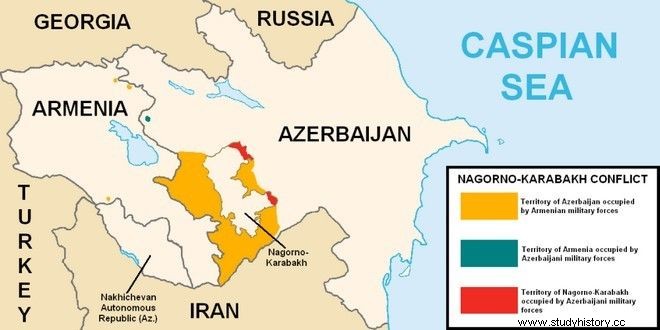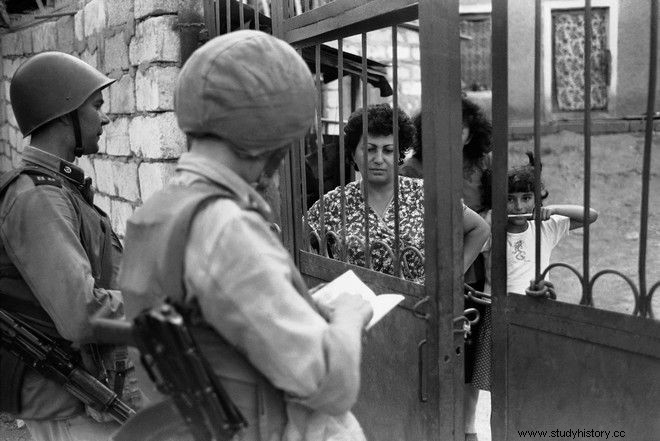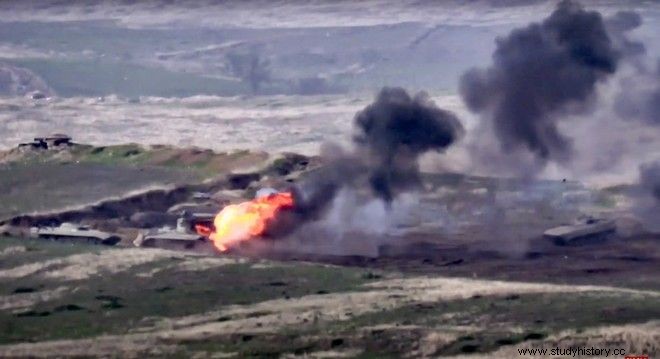The climate between Armenia and Azerbaijan is tense, after the deadly clashes that broke out on Sunday (09/27) in the Nagorno-Karabakh region. The international community expresses strong concern and fears of war between the two countries.
Nagorno-Karabakh is a region of Azerbaijan that has broken away from the rest of the country, is inhabited mainly by Armenians, and is supported by Armenia. The region is disputed, internationally recognized as part of Azerbaijan, but most of the region is under the control of the Artsakh Republic (until February 2017 known as the Nagorno-Karabakh Republic), a de facto independent state with an Armenian majority.
In light of the recent fighting over Nagorno-Karabakh, we list five things you should know about the disputed region.
1. Where exactly
is it?Nagorno-Karabakh is a region in the South Caucasus, located between the regions of Nagorno-Karabakh and Zangezur and covering the southeastern range of the Lesser Caucasus. The region is mainly mountainous and forested and coincides with the administrative boundaries of the former Nagorno-Karabakh autonomous region, which includes an area of 4,400 square kilometers. It has high ridges along the northern edge and along the west and mountainous south.
The territory of today's Nagorno-Karabakh region is part of the historical region of Karabakh, which is located between the Kyros and Araxi rivers. The landscape in Nagorno-Karabakh differs from the Kyros River steppe with plains through dense oak and beech forests. The area has many thermal springs and deposits of zinc, coal, lead, gold, marble and limestone.

2. Its
rootsNagorno-Karabakh falls within the territories of the people known to modern archaeologists as the Kura-Araxes, because they lived between these two rivers. The ancient population of the region consisted of various indigenous local groups and migrating tribes who were mostly non-Indo-European. Armenian civilization flourished during the early medieval period in Nagorno-Karabakh, while around the middle of the 7th century, the region was conquered by invading Muslim Arabs, then ruled by local rulers approved by the Caliphate, and in 1805 Karabakh became a protectorate of the Russian Empire, while after the outcome of the Russo-Persian War (1804-1813) Persia officially ceded Karabakh to the Russian Empire.
The current conflict over Nagorno-Karabakh has its roots in Joseph Stalin's decisions during the Transcaucasian invasion. After the Russian Revolution of 1917, Karabakh formed part of the Transcaucasian Democratic Federal Republic, but it soon disintegrated into the separate Republics of Armenia, Azerbaijan, and Georgia. The next two years (1918-1920) saw some brief wars between Armenia and Azerbaijan over several territories, including Karabakh. In July 1918, the first Nagorno-Karabakh Armenian Assembly declared the region self-governing and established a National Council and government.
After the defeat of the Ottoman Empire in World War I, British troops occupied Karabakh. In February 1920, the National Council of Karabakh agreed to come under the jurisdiction of Azerbaijan, while the Armenians waged a continuous guerilla war in Karabakh, not accepting the agreement. The agreement itself was soon annulled by the 9th Karabakh Assembly, which declared union with Armenia.
On August 10, 1920, Armenia signed a preliminary agreement with the Bolsheviks, agreeing to a temporary occupation of these territories by the Bolsheviks until a final settlement. With the Soviet Union firmly in control of the region, the conflict stalled for several decades. With the beginning of the dissolution of the Soviet Union in the late 1980s and early 1990s, however, the Nagorno-Karabakh issue resurfaced. Blaming the government of Azerbaijan for the Azeriization of the region, the majority of the Armenian population with the ideological and material support of the Armenian government started a movement for the autonomy of the region. In August 1987, Karabakh Armenians sent a petition for union with Armenia with tens of thousands of signatures to Moscow.
3. War and secession
The territorial and ethnic conflict between Armenia and Azerbaijan over the disputed Nagorno-Karabakh region has its roots in the early 20th century, although the current conflict began in 1988 and escalated into full-scale war in the early 1990s. On 13 February 1988 Armenians began to demonstrate in the capital Stepanakert in favor of unification with the Republic of Armenia. Six days later there were mass marches in Yerevan.
On February 22, 1988 a large group of Azerbaijanis marched from Agdam against the Armenian population in the town of Askeran. Large numbers of refugees fled their homes from Armenia and Azerbaijan as violence began against the minority populations of the respective countries. On 10 December 1991, in a referendum boycotted by local Azeris, Armenians in Nagorno-Karabakh approved the creation of an independent state, and a full-scale war broke out between Azerbaijan and Nagorno-Karabakh, with the latter receiving support from Armenia .

4. Russia
's illegal "ceasefire".By the end of the war in 1994, the Armenians had full control of the territory (with the exception of the Shaumyan region) except for the surrounding areas of Azerbaijan, most notably the Lachin Corridor, a mountain pass connecting Nagorno-Karabakh to mainland Armenia. An illegal Russian ceasefire was signed in May 1994, but regular peace talks between Armenia and Azerbaijan mediated by the OSCE Minsk Group failed to lead to a peace treaty.
This has left the Nagorno-Karabakh region in a state of legal limbo, while the Nagorno-Karabakh republic remains de facto independent but internationally unrecognized, while Armenian forces currently control about 9% of Azerbaijan's territory outside the territory. As a result of the conflict, 230,000 Armenians have been displaced from Azerbaijan and 800,000 Azeris from Armenia.
Despite the ceasefire, deaths due to armed conflicts continued. On 25 January 2005, the Parliamentary Assembly of the Council of Europe (PACE) adopted PACE Resolution 1416, which condemned the ethnic cleansing against the Azeris. The borders that emerged after the 1994 ceasefire have remained untouched to this day.
5. The current state
Today, the Republic of Artsakh is a de facto independent state. It has close relations with the Republic of Armenia and uses the same currency, the dram. Armenian governments have repeatedly come under international pressure not to unite the two states, due to the negotiations being held under the auspices of the OSCE Minsk Group.

The mediation process is currently at a standstill, with the most recent talks in Rambouillet, France not leading to an agreement. Azerbaijan has formally demanded that Armenian troops be withdrawn from all disputed areas of Azerbaijan except Nagorno-Karabakh and that all displaced persons be allowed to return to their homes.
Armenia claims that Nagorno-Karabakh does not belong to Azerbaijan and believes in the self-determination of the region's residents.
In 2008, the president of Azerbaijan, Ilham Aliyev, declared that "Nagorno-Karabakh will never become independent, our position is supported by international mediators, Armenia must accept reality." On 14 March 2008, the United Nations General Assembly adopted a non-binding resolution by a vote of 39 to 7, with 100 abstentions, affirming the territorial integrity of Azerbaijan and expressing support for the country's internationally recognized borders, demanding the immediate withdrawal of all of the Armenian forces from all the occupied territories.
Read the News from Greece and the world, with the reliability and validity of News247.gr.
